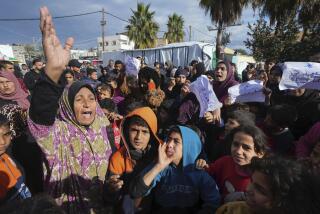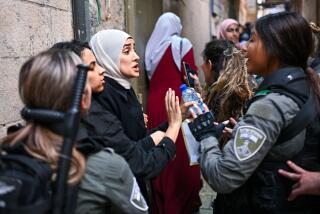Troops’ Fatal Mix-up Shows Deep Distrust
- Share via
MANILA — At the height of Friday’s bloody uprising in the Philippine Armed Forces, army Capt. Ricardo Morales received a battle wound that he said will never be a source of pride.
A combat veteran, Morales and thousands of fellow soldiers had decided to side with President Corazon Aquino against a politically powerful band of nearly 1,000 renegade troops mutinying against her rule. And Morales was aboard one of many armored vehicles that moved up Friday afternoon to reinforce an outnumbered band of loyalist Aquino soldiers trying to assault the rebel stronghold at Manila’s Camp Aguinaldo.
Fire on Reinforcements
Suddenly, several Aquino loyalists turned and fired on the arriving reinforcements. A five-minute battle left 13 civilian bystanders and two soldiers dead and dozens of others wounded, among them Morales, who had taken part in the 1986 military-civilian coup that overthrew then-President Ferdinand E. Marcos.
What happened was a mistake, a military spokesman, Col. Honesto Isleta, announced an hour later. “A misencounter,” Isleta called it, “bad communication.”
But to Morales, who had been jailed by Marcos as a dissident at the onset of last year’s coup, the incident is a source of shame. He said that he will wear it as a scar for the rest of his life on his chin where a bullet hit him.
Sign of Military Mistrust
For several Western military observers, who joined journalists to witness seven hours of fighting between loyalists and rebels--each side holed up in one of Manila’s two major military camps--it was an illustration of the deep divisions, distrust and demoralization now plaguing the 155,000-member Philippine Armed Forces.
“It doesn’t matter who wins this battle,” one Western military analyst said as artillery and mortar shells arced across the major Manila thoroughfare that divides the two camps. “No matter who wins, the military loses.”
Brig. Gen. Edgardo Abenina, regional constabulary commander for the central Philippines with headquarters in Cebu City, who declared his support for the rebels Friday afternoon, described the situation in even stronger terms in a telephone interview with The Times.
Foresees Another Uprising
“This is not the end of it--even if it is crushed today,” Abenina said after Gen. Fidel V. Ramos, Aquino’s armed forces chief of staff, had regained control of the last of the main Manila military installations seized by the rebels. “It is not over, because every incident like this that fails becomes the fertilizer that nurtures the seed for the next. And each incident becomes more violent than the last.”
Ramos gave orders relieving Abenina of his command after hearing of his support for the mutiny and later announced that Abenina had been placed under arrest.
Abenina, a Marcos opponent who took part in the 1986 coup that drove the former president into exile in Hawaii, stressed that none of the mutinous troops involved in Friday’s uprising were favorable to Marcos. In fact, he said, they believed they were “finishing the job we began 18 months ago.”
“This administration is going the same way Marcos’ did,” the general said. “A revolution cannot be effective unless there is a cleansing effect. A bloodless revolution is no revolution at all.”
Insist Military United
Ramos and his senior military commanders insisted after Friday’s bloodshed ended that the armed forces are united and solidly behind Aquino’s government. These same officers have made the same claim after each of the last five failed coup attempts against Aquino.
In reality, divisions within the armed forces have deepened radically just in the 24 hours since Col. Gregorio Honasan led his mutineers in almost simultaneous attacks on five key government installations in Manila early Friday morning, the Western military analysts said.
Honasan, a decorated combat veteran who became a national legend for parachuting into guerrilla fighting areas on Mindanao in the mid-1970s with a boa constrictor around his neck, was the logistical combat expert who stood beside Gen. Ramos in their fight against Marcos.
Honasan was chief of security for Defense Minister Juan Ponce Enrile, who, with Ramos, led the 1986 coup. And most of the men who rebelled with Honasan against Aquino were among the inner circle of troops who had protected Enrile and Ramos during the three-day 1986 revolt.
Another reflection of the widening divisions here was Aquino’s action, in which she condemned Honasan and his followers on nationwide television as “traitors” and “monsters” to whom she has “nothing to say.”
Attacks, Not Talks
Moreover, Ramos made no effort during Friday’s uprising to try to negotiate with his former supporters, moving instead, on Aquino’s orders, to attack Honasan’s positions with heavy artillery, helicopter gunships and rocket-firing planes.
Gen. Abenina noted that Honasan and several other key leaders of the mutiny had simply disappeared with a majority of their troops when their Friday uprising failed and said, “The seeds of the government’s future dilemmas have now been sown.”
Several other significant signs of the split and the ensuing ineffectiveness of the military were evident during Friday’s drama.
From the first mutinous attack on the Malacanang presidential palace at 1 a.m. until late in the afternoon, there were no army, navy, marine or air force troops among the soldiers sticking loyally by Ramos and Aquino. The government’s force consisted of elements from the Philippine Constabulary, a special combat police force that Ramos headed for many years.
“My guess is that the thing that turned the tide against Col. Honasan was when the army decided not to join him,” one Western military source said. “The army decided to go with Cory (Aquino) this time. But next time, who knows?”
It was not until Morales and his column of soldiers and marines moved into Camp Aguinaldo and the air force sent two fighter planes to rocket the camp that Ramos’ assault had any apparent chance of success.
Troops Hid Behind Cars
Before the army and marines arrived, most of Ramos’ constabulary forces hid behind cars or walls when bursts of gunfire erupted. Scores were seen crouching under desks in Camp Crame, the national police headquarters where Ramos set himself up across the street from Camp Aguinaldo.
Several times, constabulary troops accidentally dropped their automatic weapons, which went off, injuring several of the thousands of civilian bystanders who watched the event as if it were a game throughout the day.
At one point during an air force raid on Aguinaldo, a frightened constabulary sergeant asked a reporter whether the plane was bombing his camp (Crame) or the rebel camp (Aguinaldo).
“There’s no question this is a sad bunch,” said a Western military analyst on the scene. “You can just imagine what they’re like when they’re out fighting the Communists.”
The armed forces’ performance against an estimated 23,000 guerrillas of the Communist New People’s Army, a rebel organization that has been waging a war in the countryside since 1969, has grown increasingly dismal, according to U.S. Defense Department sources and the Philippine soldiers themselves. Regional commanders such as Abenina have blamed that poor performance on the demoralizing effects of splits within the military.
Sees Schism in Ranks
“There is a deep schism between the soldier who is interested in his duty, and the officer who is in it for personal gain,” Abenina said in the telephone interview with The Times.
“The lower-level soldiers--the underdogs--they cannot take advantage of political patronage, as the senior officers are doing. They do the dirty work and plow through the fields while the generals and colonels are up there in their air-conditioned offices talking to politicians.
“And the problem is deepening to the point where we have lost our identity as an organization.”
The key question, according to Abenina and key Western military analysts, is what will happen the next time mutinous troops rise against Aquino.
One army lieutenant, who asked not to be identified by name, appeared to have already made his decision Friday.
“When our own troops start shooting at us, injuring us, killing us, while all we’re trying to do is come to their rescue,” he said, “well, I’m not so sure I want to be on their side next time. And, at this rate, there will be a next time.”
More to Read
Sign up for Essential California
The most important California stories and recommendations in your inbox every morning.
You may occasionally receive promotional content from the Los Angeles Times.













